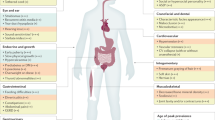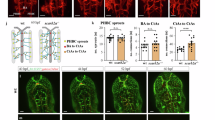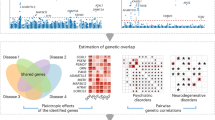Abstract
Williams–Beuren syndrome (WBS) is a neurodevelopmental disorder with multi-systemic manifestations, caused by a heterozygous segmental deletion of 1.55–1.83 Mb at chromosomal band 7q11.23. The deletion can include the NCF1 gene that encodes the p47phox protein, a component of the leukocyte NADPH oxidase enzyme, which is essential for the defense against microbial pathogens. It has been postulated that WBS patients with two functional NCF1 genes are more susceptible to occurrence of hypertension than WBS patients with only one functional NCF1 gene. We now describe two extremely rare WBS patients without any functional NCF1 gene, because of a mutation in NCF1 on the allele not carrying the NCF1-removing WBS deletion. These two patients suffer from chronic granulomatous disease with increased microbial infections in addition to WBS. Interestingly, one of these patients did suffer from hypertension, indicating that other factors than NADPH oxidase in vascular tissue may be involved in causing hypertension.
Similar content being viewed by others
Log in or create a free account to read this content
Gain free access to this article, as well as selected content from this journal and more on nature.com
or
References
Francke U : Williams-Beuren syndrome: genes and mechanisms. Hum Mol Genet 1999; 8: 1947–1954.
Perez Jurado AL : Williams-Beuren syndrome: a model of recurrent genomic mutation. Horm Res 2003; 59 (Suppl 1): 106–113.
Del Campo M, Antonell A, Magano LF et al: Hemizygosity at the NCF1 gene in patients with Williams-Beuren syndrome decreases their risk of hypertension. Am J Hum Genet 2006; 78: 533–542.
Baumer A, Dutly F, Balmer D et al: High level of unequal meiotic crossovers at the origin of the 22q11. 2 and 7q11.23 deletions. Hum Mol Genet 1998; 7: 887–894.
Gorlach A, Lee PL, Roesler J et al: A p47-phox pseudogene carries the most common mutation causing p47-phox- deficient chronic granulomatous disease. J Clin Invest 1997; 100: 1907–1918.
Casimir CM, Bu-Ghanim HN, Rodaway AR, Bentley DL, Rowe P, Segal AW : Autosomal recessive chronic granulomatous disease caused by deletion at a dinucleotide repeat. Proc Natl Acad Sci USA 1991; 88: 2753–2757.
Roos D, Kuhns DB, Maddalena A et al: Hematologically important mutations: The autosomal recessive forms of chronic granulomatous disease (second update). Blood Cells Mol Dis 2010; 44: 291–299.
van den Berg JM, van Koppen E, Ahlin A et al: Chronic granulomatous disease: the European experience. PLoS One 2009; 4: e5234.
Lassegue B, San Martin A, Griendling KK : Biochemistry, physiology, and pathophysiology of NADPH oxidases in the cardiovascular system. Circ Res 2012; 110: 1364–1390.
Kabuki T, Kawai T, Kin Y et al: A case of Williams syndrome with p47-phox-deficient chronic granulomatous disease. Nihon Rinsho Meneki Gakkai Kaishi 2003; 26: 299–303.
Gilbert-Barness E, Fox T, Morrow G, Luquette M, Pomerance HH : Williams syndrome associated with Crohn disease, multiple infections, and chronic granulomatous disease. Fetal Pediatr Pathol 2004; 23: 29–37.
Boyum A : Isolation of mononuclear cells and granulocytes from human blood. Isolation of monuclear cells by one centrifugation, and of granulocytes by combining centrifugation and sedimentation at 1 g. Scand J Clin Lab Invest 1968; 9 (Suppl): 77–89.
Cohen-Tanugi L, Morel F, Pilloud-Dagher MC et al: Activation of O2(-)-generating oxidase in an heterologous cell-free system derived from Epstein-Barr-virus-transformed human B lymphocytes and bovine neutrophils. Application to the study of defects in cytosolic factors in chronic granulomatous disease. Eur J Biochem 1991; 202: 649–655.
Zhou M, Diwu Z, Panchuk-Voloshina N, Haugland RP : A stable nonfluorescent derivative of resorufin for the fluorometric determination of trace hydrogen peroxide: applications in detecting the activity of phagocyte NADPH oxidase and other oxidases. Anal Biochem 1997; 253: 62–168.
Hasegawa H, Suzuki K, Nakaji S, Sugawara K : Analysis and assessment of the capacity of neutrophils to produce reactive oxygen species in a 96-well microplate format using lucigenin- and luminol-dependent chemiluminescence. J Immunol Methods 1997; 210: 1–10.
Stasia MJ, Brion JP, Boutonnat J, Morel F : Severe clinical forms of cytochrome b-negative chronic granulomatous disease (X91-) in 3 brothers with a point mutation in the promoter region of CYBB. J Infect Dis 2003; 188: 1593–1604.
Laemmli UK : Cleavage of structural proteins during the assembly of the head of bacteriophage T4. Nature 1970; 227: 680–685.
Towbin H, Staehelin T, Gordon J : Electrophoretic transfer of proteins from polyacrylamide gels to nitrocellulose sheets: procedure and some applications. Proc Natl Acad Sci USA 1979; 76: 4350–4354.
Vergnaud S, Paclet MH, El Benna J, Pocidalo MA, Morel F : Complementation of NADPH oxidase in p67-phox-deficient CGD patients p67-phox/p40-phox interaction. Eur J Biochem 2000; 267: 1059–1067.
Dekker J, de Boer M, Roos D : Gene-scan method for the recognition of carriers and patients with p47(phox)-deficient autosomal recessive chronic granulomatous disease. Exp Hematol 2001; 29: 1319–1325.
Menten B, Maas N, Thienpont B et al: Emerging patterns of cryptic chromosomal imbalance in patients with idiopathic mental retardation and multiple congenital anomalies: a new series of 140 patients and review of published reports. J Med Genet 2006; 43: 625–633.
Bradford MM : A rapid and sensitive method for the quantitation of microgram quantities of protein utilizing the principle of protein-dye binding. Anal Biochem 1976; 72: 248–254.
Campuzano V, Segura-Puimedon M, Terrado V et al: Reduction of NADPH-oxidase activity ameliorates the cardiovascular phenotype in a mouse model of Williams-Beuren Syndrome. PLoS Genet 2009; 8: e1002458.
Acknowledgements
MJS is grateful for support from the University Joseph Fourier, Faculty of Medicine; the Ministry of Education and Research, MENRT; the Regional Clinical Research Department, DRCI, Grenoble University Hospital, the CGD Research Trust grant award reference J4G/09/09. DR is co-recipient of an E-Rare research grant on CGD from the European Union.
Author information
Authors and Affiliations
Corresponding author
Ethics declarations
Competing interests
The authors declare no conflict of interest.
Rights and permissions
About this article
Cite this article
Stasia, M., Mollin, M., Martel, C. et al. Functional and genetic characterization of two extremely rare cases of Williams–Beuren Syndrome associated with chronic granulomatous disease. Eur J Hum Genet 21, 1079–1084 (2013). https://doi.org/10.1038/ejhg.2012.310
Received:
Revised:
Accepted:
Published:
Issue date:
DOI: https://doi.org/10.1038/ejhg.2012.310
Keywords
This article is cited by
-
Dental-craniofacial manifestation and treatment of rare diseases
International Journal of Oral Science (2019)
-
Neutrophils at work
Nature Immunology (2014)



